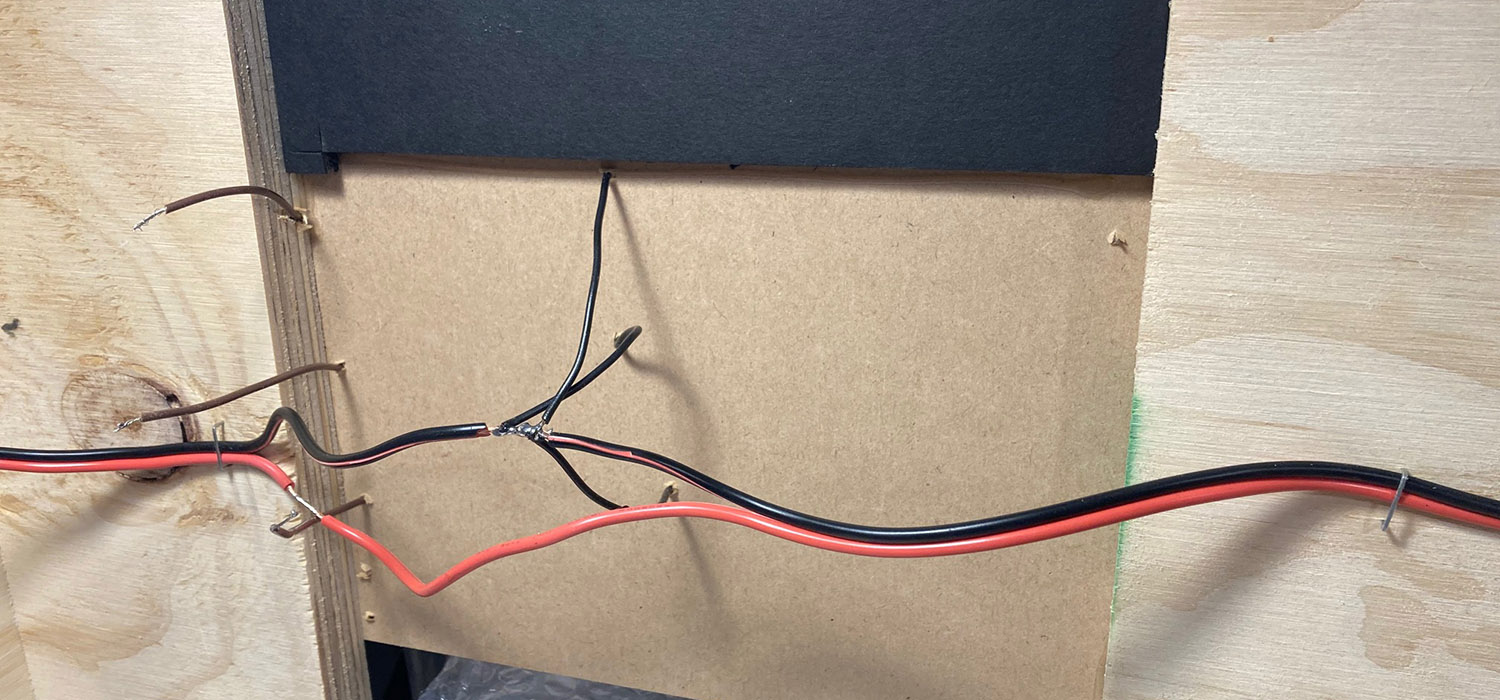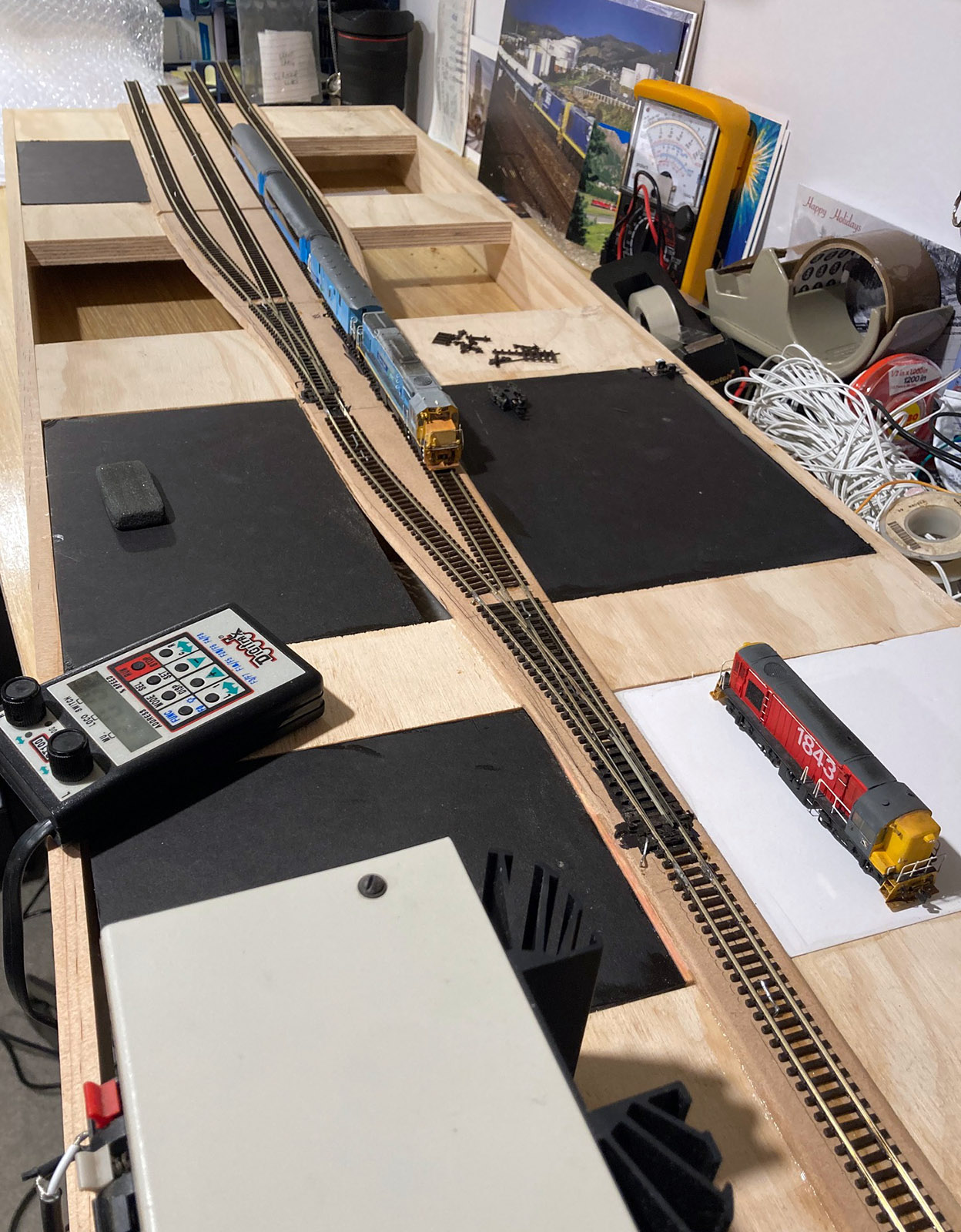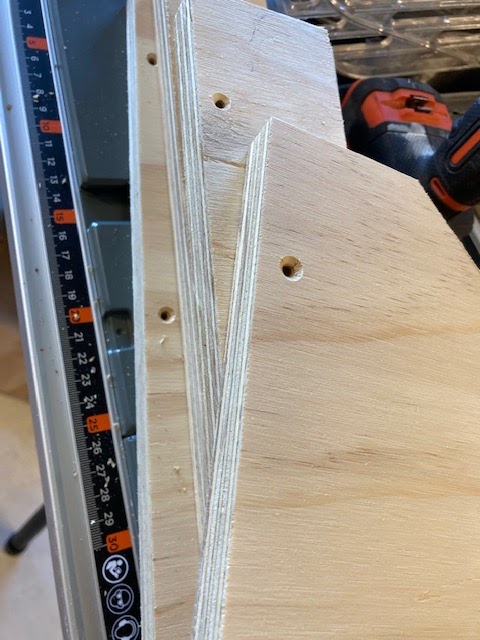DB returns: I have always felt that NZ120 needed a modular standard to take off.
Contributing a module makes you feel a part of something larger. Building a module is more achievable than building a big home layout. A module can still be used as part of a home layout, even if you model other prototypes on 9mm gauge track, or just to display your NZ120 wares. Getting a layout together can be an inspiration and a driver to get things done. A module is a project that doesn’t have to be expensive, or time consuming, or take up a lot of space. It could be put in a bag and live under a bed or in a wardrobe or in the garage. It’s all positive stuff really.
There have been NZ120 modular standards before, but this is different. Mainly because there are almost no rules, so that makes it really easy to participate.
The only important rules are the locations of the holes in the faceplate in relation to the track, the height above the floor, and the electrical plugs. Obviously at home you can set the thing up at any height you want. And if you don’t have holes in your module, you could simply bust out a drill on the day. There are plenty of recommendations and suggestions in the Fremo120 standard, but there are few real rules.
So since my grand plans for other projects have yet to bear any fruit, and my Z scale adventures are running out of steam, why not start an NZ120 module? When Mr Dandruff visited last week, we blew the dust off some boxes of NZ120 stuff that hadn’t been opened for ten years, and it seems I have a lot more rolling stock than I remember. Despite some items being more than 30 years old, some of it even still looks half decent (from the mandated viewing distances). So this might be an easy way of getting back into modelling.
A simple Fremo120 module could :
- Be used as part of my home layout.
- Form part of an exhibition layout (typically a round-round layout with train crossings like Otaki to Cass was, with operators inside, backdrops to make proper scenes, etc.
- Form part of the more traditional ‘Fremo style’ gathering, which is typically more for layout operators than the public, is usually 'operations-focussed' (rather than simply running trains around in circles), typically with modules set up in a long end-to-end mainline (sometimes with turn back loops at the ends), usually with no backdrops, usually operated from both sides.
I don’t see why my module can’t do all three.
I intend have this module set up at home, where it might see an NZ120 coal train pass across it one minute, a long SP oil train with mid-train helpers the next, only to be followed by a jaunty RhB Allegra railcar leading the Bernina Express. It will be portable enough to travel to exhibitions, whether they be public shows or private Fremo operator sessions. My personal preference is to have backdrops, but these might be removable for true Fremo-style operating sessions.
So in my usual all-or-nothing style, I have decided to build a module. Well three actually. I had my sights set on a west coasty bridge of some sort, Waimangaroa north of Westport, or Aratuna on the Hokitika branch. Probably on a curved module, because if nobody makes curved modules, eventually you run out of straight-line room in your room. Or your hall.
(Insert sound of needle being scratched across a record.) Instead, I have decided to make three modules representing Studholme (or Studholme Junction if you are a little older).
Huh? A flatland station? Isn’t that a little unspectacular? Why yes it is. Some reasoning please?
While the wide open spaces and broad curves of Cass were clearly the highlight of the Otaki to Cass exhibition layout (with the Makatote viaduct as an unsubtle exclamation point), Otaki was the straight man, the dependable sidekick, the right hand man who holds things together while the hero runs amok. “Behind every Cass there’s an Otaki” as the old saying goes.
Any layout, at home or exhibited, needs somewhere to stage trains. When you get sick of running one, or the loco is getting tired and its wheels need cleaning, you pull that train off and put another on show. For operational interest, given that NZ120 isn’t really a ‘shunting’ scale, it’s also nice to have somewhere to cross trains. A station is also a place you can have models on display (especially if they don’t run that well!) which provides visual interest for punters and operators.
If you get really enthusiastic, you can shunt or shuffle things around in a yard. Otaki, being blocked-DC, had two mainline controllers, but the 4th track plus goods shed loop road and the ballast pit sidings were another block that could optionally be run with a third controller. This meant you could test things or shuffle stuff around without impacting core mainline operations.
Otaki worked well because :
- It had space for four decent sized trains (plus the goods shed loop and ballast sidings that could house smaller trains).
- The loops were long enough to take our longest trains - it could stable 20 bogie wagon or 35+ 4w wagon trains.
- It worked well. It’s modules were located together with dowels and bolted together, rails were soldered to PCB at the joins, tracks crossed module joins at 90 degrees, the layout was mainly straight, it was flat, and it had smooth radius points (only the goods shed road points were a bit finicky).
So... as you can see, I’ve talked myself into building Studholme, or basically Otaki II.
Studholme was the prototype inspiration because:
- It had an interesting yard layout for a small station in the middle of nowhere.
- It had two big loops that could store long trains (one strung out around a bulbous island platform), plus a goods shed road, and several other tracks. Someone who worked there told me that because of track work and the need to cross several trains together at Studholme, that they once had to put the Southerner through the goods shed… so there is precedent for using all the tracks for trains!
- It was formerly a junction for the Waimate Branch, so in a Fremo-120 layout, it could be a useful puzzle-piece spawning a little branchline or third mainline leg.
- It had a coal merchant that received LAs and LCs, two large grain and seed warehouses, a goods shed, a gantry crane, stockyards, a large high level loading bank, a smaller low-level one that often received new cars, and a track around the back of the goods shed with another long low level loading back where berryfruit and produce were loaded into Z wagons. In my fantasy world, I’d base a DSC or DSG there to shuffle all this local traffic about, even in NZ120.
- As for structures, depending on the era chosen, it had either an unusual transverse wooden station, or an unusual modern station. It had a signal box(!) until about 1980, and jigger sheds until the early 90s. The traditional goods shed was replaced before steam ended by a large steel one that went on to become Mainline Steam’s Christchurch shed. Concrete supports for one of the water vats are still visible. The seed stores still remain, as does an interesting pub over the west fence, which was once accessed by a wooden overbridge.
- So you could run many eras of equipment through here without it looking awkward.
- Scenically, the area is pretty featureless, so should be easy to build.
- Because the scenery is flat, three 1.2m sections should be able to be stacked together to fit across the back seat of a car, making it easy to transport to gatherings.
- Studholme is where I used to watch trains as a young 'un.
So this is my plan.
Three 1.2 metre modules will give ample length for crossing trains, yet fit in the back seat of a car. The fairly plain modules will be 40cm wide. I like what Rhys did with flowing sides at Paekok, and this might have worked well with the central module here to give more depth for another track (or more open space), but the goal is to have it compact enough to fit in a back seat, so practicality trumps prettiness, and these will be straight sided blando-rectangles.
Hopefully, more to come.....
 |
| South end looks doable on a 40cm x 1.2m module |
 |
| Train 180 drops off coal in the early 1980s |




















































